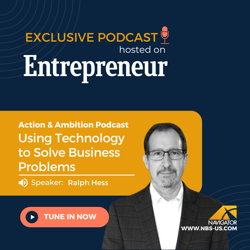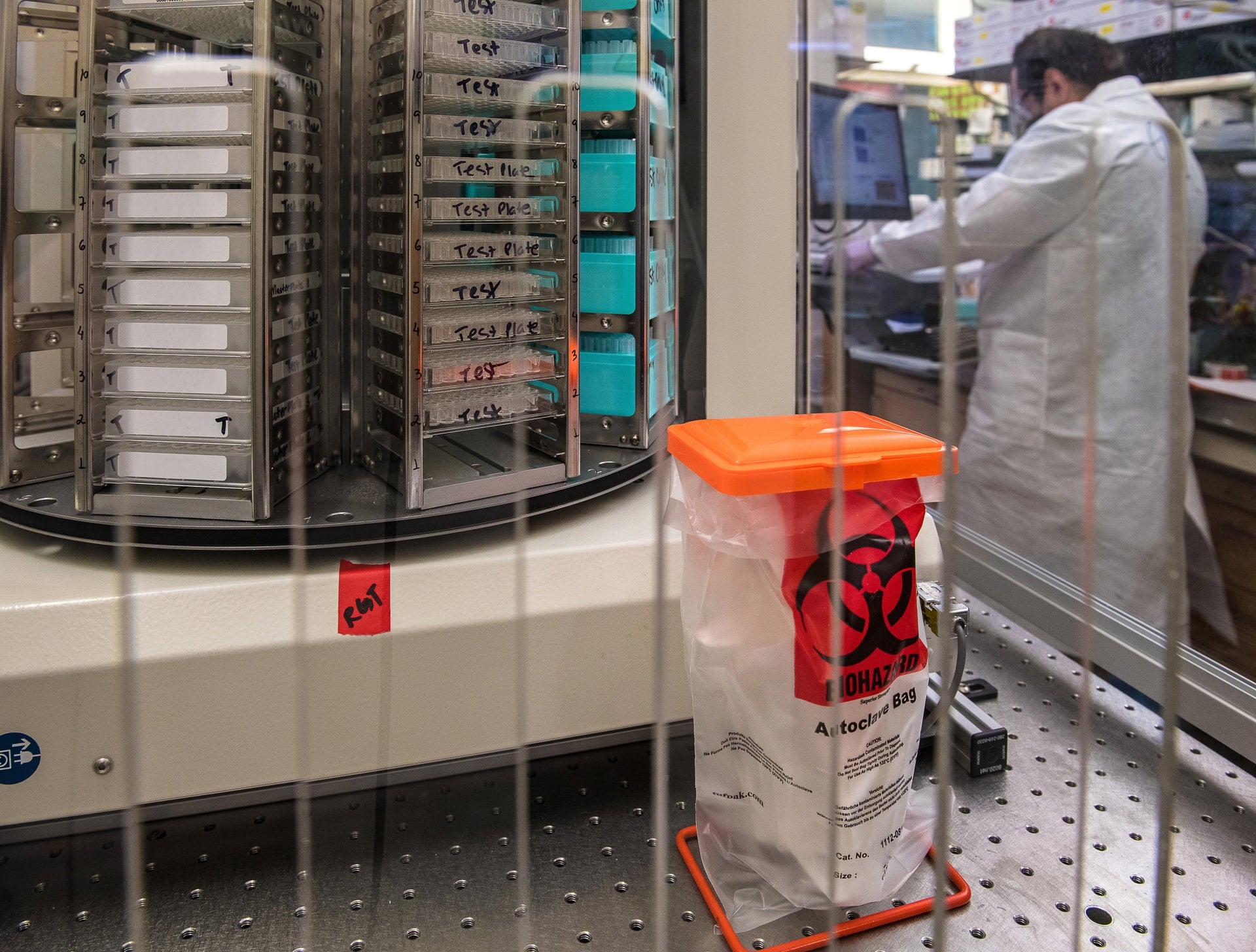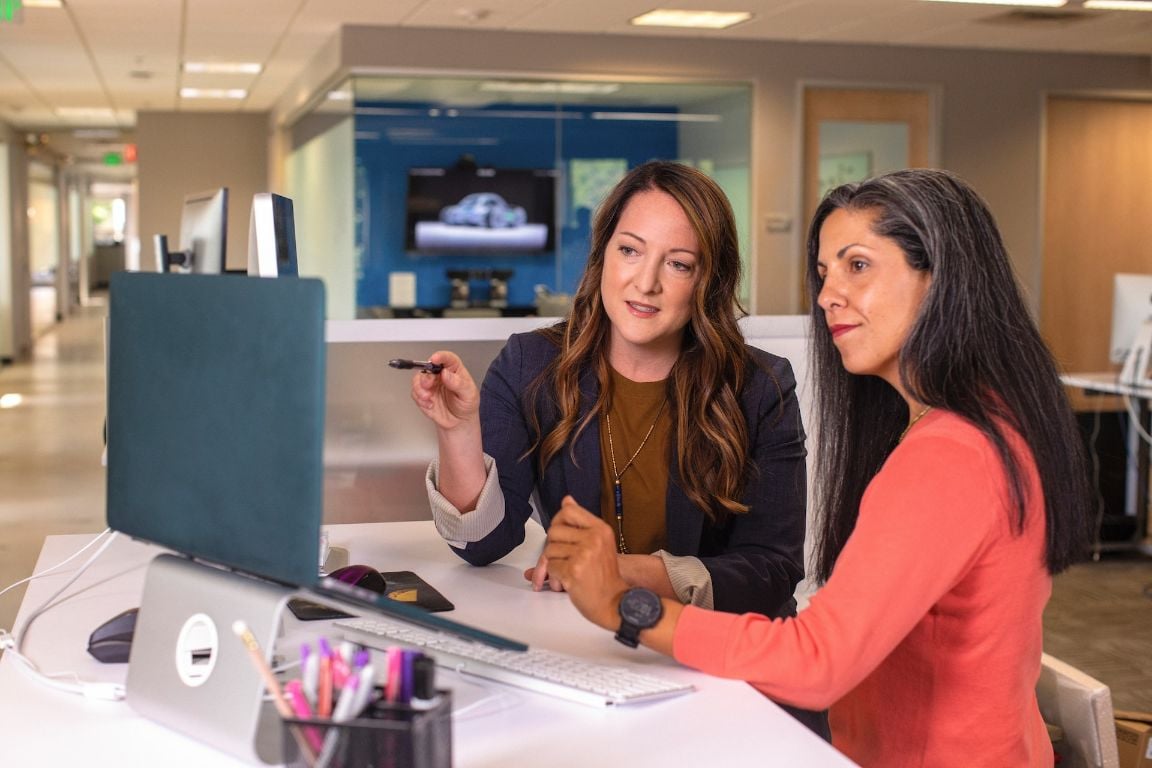Action and Ambition Podcast Hosted by Andrew Medal
Ralph Hess On Using Technology To Solve Business Problems - Navigator Business Solutions

In this episode, we are joined by Ralph Hess, the Executive Vice President of Sales and Marketing at Navigator Business Solutions, a computer software company that provides cloud-based ERP business solutions. It configures and implements ERP solutions built on SAP Business One and SAP Business ByDesign, so clients can break free of the limiting and disconnected business systems that hold them back from achieving their true growth potential. Ralph has over 30 years of experience helping companies solve their business problems with technology, working with multiple publishers, including IBM, Epicor, and Microsoft.
Tune in to learn more!
Entrepreneur.com | Apple Podcasts | Google Play Music | Spotify | Stitcher
[TRANSCRIPT]
Chase: (00:00)
This is Action and Ambition, this show that takes you all over the world to share interviews with the most successful and relevant people on the planet, Hear their backstory, get the most important lessons they've learned on their road to success, and hear exclusive tips on how to implement their success in your own life. Action and ambition is brought to you by Entrepreneur Magazine in your host, Andrew Medal.
Chase: (00:32)
Welcome to the Action and Ambition podcast. I'm your host today, Chase Geyser. And with us, we have a very special guest. Ralph Hess is the Executive Vice President of Sales and Marketing at Navigator Business Solutions, a computer software company that provides cloud-based ERP business solutions. Ralph has over 30 years of experience in helping companies solve their business problems with technology, working with multiple publishers, including IBM, Epicore, and Microsoft. Ralph is an honor and a pleasure to have you on the Action and Ambition Podcast. How are you today, sir?
Ralph: (01:02)
I'm great, Chase. How you doing today?
Chase: (01:04)
I'm doing well. So where does this where does this story begin for you? Where was your mind at when you graduated from high school?
Ralph: (01:10)
. . That's a great question. My mind was at going to engineering school and playing soccer, not necessarily in that order.
Chase: (01:18)
Okay, very good. So, so were you playing soccer in
Ralph: (01:22)
College? What, what's interesting is, you know, my journey into technology really started there. I was it started with a very, very, back in the late seventies, which is before a lot of your listeners were born. You know, started out as in a, a programming class, four engineerings. And from there I kind of caught the bug of what a computer could do to solve problems.
Chase: (01:46)
So what was a programming class like in the late seventies? I mean, were you using like a reel-to-reel or something?
Ralph: (01:51)
Oh, no. Goodness. It was even before that Chase, we used to actually punch cards. Wow. Yeah, I go back, I go way back, way back machine, even before the movie, Back to the future
Chase: (02:03)
. So what, I mean, what kind of stuff would your, would your program do? I mean, was what kind, what kind of programs could you make on a computer like that?
Ralph: (02:10)
Oh, you could, you know, well, you were, you were solving for for physics in, in mathematical equations at that point. So,
Chase: (02:16)
So like long division, you
Ralph: (02:17)
Know, honestly, you know, as, as as luck would have it I did like the, the challenge of solving problems using computers. I didn't necessarily love engineering. I did love soccer and soccer played a big role in me making it into business school
Chase: (02:35)
In, How did that work? Just network networking.
Ralph: (02:39)
. Pardon me?
Chase: (02:41)
So was it just the networking of playing soccer with, with other people that got you into the sort of the business side or, or what, what's up with that? Or you were so distracted with soccer.
Ralph: (02:50)
A busy soccer schedule is really incompatible with the rigors of a mechanical engineering degree.
Chase: (02:56)
. That makes sense. That makes, that makes sense. So you switched from engineering to business just because you're having a hard time keeping up with the demands of the curriculum?
Ralph: (03:04)
Exactly. Exactly.
Chase: (03:06)
Okay. Okay. And did you find, did you find the relief that you were looking for in studying business, or did you find that it was
Ralph: (03:10)
No, I did, but it's really interesting, Chase, because I didn't, you know, I, I found, so I, I went into more of quantitative methods for business analytics track mm-hmm. which allowed me to continue to explore Computer Earth and, and also now start to take a look at applying that to business problems. And you know, there was a point in my, my junior year, mid junior year where I, I just became impatient. That's really been a hallmark of my career. Mm. And really didn't believe that the guys who were teaching in college at that point really had the practical experience in helping me get where I wanted to go. So I actually left college at that point, finished up at night but went and got a $ 5-an-hour programming job with an ibm business partner. And at that point is real, like, where I really caught the bug for saying, Okay, here's business problems that companies really have and they need help solving them using computer programs.
Chase: (04:11)
I see. Okay. So when did you, when did this sort of like entrepreneurial aspect kick in for you? So I see that you're executive vice president of sales now at Navigator Business Solutions, but what e any sort of sort of like c-suite level or leadership level in a, in a real business in my opinion, is very entrepreneurial, especially something that's sales-oriented. Oh, absolutely, absolutely
Ralph: (04:35)
Mean. I did have my, Hey, I had a, a 15 year entrepreneurial, I owned my own business, right. So I was always entrepreneurial. In fact, I continue to be very entrepreneurial in inside of, of navigator. Yeah. But the journey took me from from that initial programming job to to kind of a fast track into consulting management and learning much more about business and going into business consulting and helping found a software consulting arm of of an engineering firm that had seen the had seen the, the business opportunity, shall we say, of expanding from engineering into into business software. So it was kind of a, an interesting two-headed business.
Chase: (05:16)
Yeah. Well, and it, it's fascinating too because with your background sort of starting in the seventies and then going all the way up to present day, I mean, you've, you've really been in the business through every epoch of of, you know, personal computing or business computing, you know, sort of solutions, right? I mean, you saw the 1984 Apple A right. Saw when Steve Jobs was fired, you saw him come back,
Ralph: (05:40)
Right? Yeah, I've seen Well, and, and it's, what's what's interesting is the more things change and more they stay the same. So yeah. As, as you look at the cycles of, of of technology and its evolution. So when I started, it was all mainframe based, and then those, those were huge IBM mainframes. Then they, they kind of disseminated those down into what were called mini computers which were still kind of a, a, a hub and spoke type type operation. So where you had your central processing unit and just dump terminals connected to it. And then with the advent of the PC came the local area network. And of course then that was the advent of all kind of the personal tools that you could use to, to leverage, to help augment whatever the, the main computer was doing for you.
Ralph: (06:25)
You could start to pull on that data and start to do some modeling, some, some problem solving yourselves. But then as we look at it, we've moved back to really some mainframe processing in the cloud, haven't we? So, yes. You know what, what people have done right, is say, Okay, well, this is great, but we don't have enough computing power and we don't want to have all the overhead of having to maintain the, the technology in, in the you know, the landscape, the technological landscape in a company. So let's put it all up in the cloud. So really, aren't we, just back to the mainframes that we had back in the late seventies,
Chase: (07:01)
There's nothing new under the sun, right, .
Ralph: (07:04)
Exactly. Exactly.
Chase: (07:05)
So were you, were you working with IBM when the nine, the famous 1984 commercial came out?
Ralph: (07:09)
Yes. Yes.
Chase: (07:10)
That was, was every, How did everybody at IBM feel about that ?
Ralph: (07:13)
Oh, yeah. Yeah. That was yeah, that was, that was a lot of fun. It was a lot of fun. It was, you know, I've been through so many different, you know, stops and starts, fits and starts in technology. Sure. it's really been a very interesting journey and it's, it's fun to sit here at, at this, this end of my career. Not that my career's at an end, but you know, this far end, this deep end into my career and really have this opportunity to recap some of some of what went on with it. Yeah. So as we, you know, as I, as I took a look at it I founded my own firm in, in 1994. We were an sap, I'm sorry, an IBM reseller. I'm, I'm linking back
Chase: (07:50)
To where I Sure. My dad was an IBM reseller in, in 94 too.
Ralph: (07:53)
Yeah. In 94. And then, we migrated from being an IBM reseller to a Microsoft-based shop. Right. A wintel shop based on Microsoft and, delivering client-server applications based upon that.
Chase: (08:08)
Okay. So were you working with Ingram Ingram Micro at the time?
Ralph: (08:12)
No. No. This, this was my own shop and, and we just, we, we sourced most of our equipment through Dell, quite frankly. That was when Dell was coming on strong and servers and, and back office platforms.
Chase: (08:25)
Yeah. I remember right when Windows XP came out, Dell had like the best deal on sort of like a personal computer that was finally affordable, that could do all sorts of things. And I remember, Yeah,
Ralph: (08:36)
That was a real computer, right? Not migrating up from an IBM three 80 or
Chase: (08:43)
Whatever it was. Right. I remember those black Dells with the black monitors though, that was super heavy. Oh, yeah. But they were awesome machines. It was like when I, I was like 10 in, in 2000. And so, you know, it was great for me because my friends and I, I started playing computer games at that time. It was the technology you got there. You could play some fun stuff at home.
Ralph: (09:00)
Yeah. You would've loved the games that I started playing
Chase: (09:03)
Ralph: (09:04)
In the way back machine. Look up Pong in Google.
Chase: (09:06)
Oh, yeah. Pong. Yeah. I played, I played some Pong, but I was more into like the StarCraft stuff. , yes. But that's awesome. So when did you get involved with Navigator Business Solutions?
Ralph: (09:16)
So, yeah, what was really interesting is I, I built up my, my own practice as an SAP. You know, we eventually be, we were a IBM business partner, then a Microsoft shop. Then we became an Epicor reseller again, kind of continuing this evolution into full blown e r P business software to run the enterprise. And we finally arrived at settling in with a, a new product from SAP back at the time, which was in 2003 called SAP Business One. And it was, you know, from sap, which was widely recognized as the, the company that invented E R P some, a solution that was geared towards a small to midsize organization. And that was right what our marketplace was. So as, as we continued to grow that business we, we leveraged a lot of opportunity through SAP, through other partners, and part of that partner network was Navigator Business Solutions.
Ralph: (10:17)
So I became friends with Grant Frazier, the founder of, of navigator. And over the years, it just, it just made sense to kind of fold things in and and then have me come lead the sales organization. So what I do in the sales organization, organization is very different, right. I'm not just a classically trained software sales guy. I take a very different leadership way of going about it in terms of being, you know, a so a problem solver. You know, I like to use the, my personal tagline is technology for business sake, not business for technology sake. I see. And it, it really kind of puts the technology where it needs to be, right? It needs to be in that support role. It needs to, it needs to enhance the business, it needs to accelerate the business. So that as, as I'm working with my sales and marketing team, that's the consistent message in way we go to market. And when you're doing that, you get the opportunity to be very entrepreneurial and starting to take off the shelf solutions and start to look at how you can bring them to bear to help their cus your customers solve their problems.
Chase: (11:25)
I see. So you'll have to pardon my ignorance, but I don't know what e r P stands for. Would you mind enlightening me?
Ralph: (11:30)
Sure, no worries. It's called Enterprise Resource Planning, and it's literally all the facets of your business that you need to automate.
Chase: (11:39)
I see. Whether
Ralph: (11:40)
It's general ed, you know, whether it's the accounting, whether it's order entry, whether it's inventory management, whether it's project management it's all those, those different facets of, of the organization that come together through one solution to be able to provide the, you know, the transaction and data automation within a company.
Chase: (12:00)
I see. Well, and one of the things too, just with the with the, the, the nature of technology over the last couple of decades is obviously it's been very fast moving, fast changing, and that's sort of a challenge it seems to me for, for major corporations who tend to have a little, little bit of bar bureaucracy, a little bit of red tape, and by the time companies get, get systems implement implemented, oftentimes it seems that the system is, is now sort of outdated compared to what the new, the new solutions might be that are available. So how do you navigate keeping these sort of systems up to date and keeping these, these companies operating at maximum efficiency through the ever changing landscape of technology?
Ralph: (12:43)
That's, that's a very perceptive question chase. So as what you described was e r p through the late nineties, and really probably up until about 2012, 2014, which is you would install a system, you would select a system, you would install it, it would take a year, 18 months to implement. By that time, everybody was so exhausted, they just hated the system anyways. But they and then everybody, again, had so much weariness over any change that was happening in the organization, anything new that that software provider or publishers I refer to them provided needed to be installed as part of kind of a major update or major upgrade. And so, you know, people would not want to, to adopt and absorb that. And when they did, oftentimes it was a painful process, meaning another three to six month project. So over the course of perhaps a, a five or six year span you know, you had probably three or four major changes going on that disrupted the business with cloud e r P.
Ralph: (13:47)
The model that's being used today, particularly by sap is one of continuous innovation. So rather than coming out with these big amorphous updates, you know, every six months, every year, what SAP is doing is introducing innovation every quarter. And it's just happening in a very seamless way. So the way they deliver their updates is, is in a way that you can test them in a test environment, decide whether you wanna adopt them or not, and then populate them into your live production environment. So the cloud e r p today is far less disruptive. And, and when we talk to CFOs and CEOs today, rather than the, the technology change of every five years to seven years, which it was back in the, in the 2000 and early 2000 teens they're now looking at 10 and 15 year decisions on their technology because they know that this solution is going to, is is feature rich enough today as it is just due to the maturity of E R P but also that now companies can innovate in a continuous fashion rather than these big, chunky ways of doing it.
Chase: (14:56)
Mm, I see. So, so the so the updating and the changing is, is has sort of found a way to, to stay on pace with, with the with the changing landscape of the technology?
Ralph: (15:06)
Yeah, exactly. Exactly. And, and let's be, let's be honest, right in e r p in running your business, there's only so many ways to do it, right? There are now what are referred to as best practices which most of the e r P providers have really encapsulated in their software. So whether you use a Microsoft product and Oracle product and SAP product, the way that you do accounting, the way you do accounts receivable, the way you do accounts payable it's all pretty much the same. Really where the innovation is happening now is at the fringes. So outside of, I'm not gonna say outside of the e R P solution, but really leveraging the data created by the E R P solution to start to create more of an intelligent enterprise. So being able to use artificial intelligence to be able to create robotics processes, to streamline operations within the software to be able to deliver advanced business intelligence that gives you better insight in making faster decisions. Those are the things really now that, particularly SAP is doing a great job of, of bringing from the large marketplace down to the small to midsize market and really making it available for the masses rather than just having it be something that's capable of being done by the Fortune 1000.
Chase: (16:27)
I see. Have you seen any impact on, on the space that you're in by the advent of blockchain technology? Or is that something that hasn't crossed over into your space yet?
Ralph: (16:34)
Has not crossed over into our space. We are very engaged with life sciences really in clinical and early stage biotech companies. And we do see that blockchain likely over the next, I would say three to five years, we'll start to see blockchain start to have an impact there. As the a lot of the drug safety act from the FDA is starting to come into play and there's gonna be a, an it really an, let's say an advanced need for being able to do some of that trace and track track and trace that that blockchain can afford.
Chase: (17:08)
Tell me a little bit about this fda act, I'm not intimately familiar with it, the Drug Safety Act.
Ralph: (17:13)
Well, yeah, in 2023, there's there's this serialization in track and trace that's going to be required for for all of the pharma companies. And just to give you an example of what it, what it is. So let's say that I'm Pfizer, right, and I'm manufacturing a vaccine. Sounds familiar, doesn't it? Yeah. And and I'm filling that vaccine into a syringe. That syringe has a serial number, right? That syringe is gonna go, go into a box. So now I have a box of 12 vaccines. That box has to have a serial number, then that box is gonna go into a case. That case then has a serial number. I then need to then through the track and trace, it's called Network Track and Trace. When that case leaves Pfizer and ends up at, let's say a McKesson distribution warehouse, it needs to be tracked all the way through to the point at which it goes to the CVS pharmacy, for instance, and then is put into the arm of the person. So
Chase: (18:16)
I see. So if there's any issue with the drug, you can trace like, which, which, which lot number or whatever which, which, like run of manufacturing might
Ralph: (18:25)
Have had the facility, which lot, which batch that came out of what filling machine that it went from the batch into the syringe, you know, what handling company what the, what the cold chin technology that was used. So, you know, was it kept at the proper temperature throughout its journey. It's it, it all has to do, you know, it's, it's a very te technology based way of ensuring the safety of the drug supply chain.
Chase: (18:51)
What catalyzed the passage of this act?
Ralph: (18:54)
Oh, I don't know. It was it was past, really about five or six years ago, and now it's really just coming due
Ralph: (19:01)
See. So it even, you know, it, it proceeds, it, it proceeds even the, the Covid pandemic. So it was something that was already in play.
Chase: (19:09)
That makes sense. So what's something that you know now that you wish you would've known when you started at Navigator?
Ralph: (19:16)
That's a great question. What I know now that I wish I knew then was that being very focused and being very intentional with how you approach opportunity can yield a lot more success than just trying to do everything.
Chase: (19:39)
Hmm, okay. That makes sense.
Ralph: (19:41)
Franklin quote, Navigator, when I first came to Navigator five years ago, was all about top line growth and taking any opportunity that we could and, and try to sell it. Now what we found is we can be vastly more successful on focusing really on just a couple of different industries, developing industry expertise and becoming the very best in that industry. In, in this case, I'm, I'm speaking specifically about life sciences and the segment of the marketplace, which is the the startup biotech.
Chase: (20:13)
Fascinating, fascinating. So have you seen any impact there's sort of this like business, international sort of global cultural movement toward esg, right? Environment sustainability and governance. Have you seen any sort of impact from that cultural business movement in, into what sort of solutions businesses are looking for in the software space?
Ralph: (20:38)
Yeah, it's really interesting. We, we have not seen that at the level of business that we're operating in. Okay. Right. We, we've got oh, I'd say of, of all of our customers, probably 20% of them are publicly traded. Probably another 40% are, are equity backed, probably in a pre i p o stage, many of them. Yeah. And then others are just privately held. And, you know, as, as we look at the market segments, again, I'm, we're dealing probably with customers that are 150 million in below, and, and frankly, many of them aren't as concerned with those types of things as they are with operating their businesses as efficiently and creatively and and achieving scale to the point where maybe they get to be a size where they start to, to have some of those considerations.
Chase: (21:25)
I understand. So where do you where would you like to see Navigator by 2025?
Ralph: (21:31)
Oh, King of the world. No, 2025, the
Chase: (21:35)
World Chico and everything in it. .
Ralph: (21:37)
Yeah, Yeah, yeah. Scarface. I think that, you know, as we look at our, at our trajectory, we, we want to be, become, we wanna evolve even more in the life science space. It's, it's such an interesting world to be involved in. You know, we have, we have customers who are working on, on the cures to Huntington's disease, various cancers very rare childhood diseases and things like that. So it's, it's fascinating and, and frankly, quite personally gratifying to be involved with those types of companies. So I would like to see us expand our footprint in, in that industry, perhaps take on beyond po beyond biotech head into pharma a bit more. And, and then there's a lot going on in med device as well. So really having us expand our footprint. Adopting, you know, right now we're a very cloud based organization. We we're one of the first SAP business partners, if you will, that were cloud only. We actually refused business that was going to be on premise. We were all cloud for about the last 10 years. So con continue our journey in really being able to bring more value to our customers. Obviously expand the customer base, but find in new and interesting ways to help our customers meet their objectives.
Chase: (22:57)
So, have you noticed anything working in this life sciences space and sort of changing the trajectory or really hyper focusing your trajectory on pharma in terms of how the business model works? And what I mean specifically is you know, there are a lot of illnesses. I'm a Type A hemophiliac, for example, that, that are very lucrative for pharmaceutical companies to treat, but not necessarily very lucrative for them to come up with a cure . So have you noticed any sort of like I don't know, I, I, have you, have you seen that dynamic play out at all so far in the space that you're in? Or is that Not really.
Ralph: (23:32)
We mean we have, so I would say that in the last, really the last 18 months or so, there's been, you know, obviously there was a huge wave of, of, you know, vaccine development, right? Sure. Everybody was was leveraging NR M RRA to to be able to go ahead and create a vaccine. You know, we have one customer that is very focused on developing vaccines for the underserved in the world. So that, that, that's one thing that's very interesting. We're starting to see in, in a couple of different facets and more of a social mission to a couple of the businesses we're engaged with. But I do see a move, a movement towards cure rather than treatment. Ah, I think that as the genome has been unpacked even further, and, and again, that technology made much more available to the to the broader audience that sure more and more bright people are, are starting to leave large pharma and really put their shoulder to the wheel of, of trying to leverage what's available out there to be able to start to create cures.
Chase: (24:36)
So you think that some of the, the cures for major illnesses may come from sort of smaller businesses rather than the major pharmaceutical businesses that are currently operating in the space?
Ralph: (24:47)
Absolutely believe that. Absolutely believe that. I think that the I think that the, I mean, the intellect of these people that we're working with are, are just amazing, right? Yeah. They're, they have their own, they have their own entrepreneurial bent, but it's, it's really their entrepreneurialism is, is is linked with a sense of mission. And it's really, really interesting to see. And I do think that when you get away from the bureaucracy, again, when you're talking about a very large pharma, there's a ton of bureaucracy. Sure. What people don't really understand, it's a lot of the small biotechs that they're, that they're subcontracting development too. So you know, as we take a look at it, we deal with a, a number of different CDMOs, which are contract drug manufacturing organizations. And they do a lot of work for a large pharma in terms of development design in, in creation of, of some of the compounds.
Chase: (25:45)
So is the current regulatory environment inhibitor to some of these smaller businesses? Like, I can't imagine as a small business owner myself, in the, in the advertising space, I can't imagine how challenging it would be to start a business that was in any way engaged in pharmaceutical development, just in terms of like FDA approvals and things of that nature. Like what does that look like if you know a team of 10 brilliant scientists with, you know, maybe $10 million wanna start a farm of business? Is it just a nightmare ?
Ralph: (26:12)
It is, it is a is it a nightmare. Well, there'll be one, one of them who is a legal guy. Yeah, there'll be four of them, which will be pure scientists. One or two will be business affairs people, and then another one will be the networking maniac who knows how to sell stuff.
Chase: (26:33)
Okay.
Ralph: (26:33)
So that, that's kind of what the, what the com, you know, composition would be of that team as you take a look at it, the, the funding is, it's greater than 10 million, right? As, as we look at people's series A, series B and series Cs, they're going from, you know, 15 million to 30 million to 50 to a hundred million in terms of their raises. If they're, you know, a number of our small biotech companies are actually have, have made it to Series E and, and they're building a plant and, you know, they're starting to prep themselves up for scale, which then at, at some point means they will either be acquired or their technology will be acquired you know, or they will go public themselves.
Chase: (27:15)
I see. So where can people find you, follow your story, as well as engage with navigator?
Ralph: (27:21)
Just come you can find me on LinkedIn, You know, I'm right there and on LinkedIn. I'm also, you can find me at ralph dot hess nbs us.com. If you go to our website, nbs us.com, look on the leadership page. I'm right there.
Chase: (27:39)
Awesome. Well, it's been an honor and a pleasure to have you on the Accident Ambition Podcast. And I hope you'll come back and join us after you've taken over the world. They'll let us know how you did it
Ralph: (27:47)
. Be happy to do that. I enjoyed the talk. Take care, Chase. Take
Chase: (27:51)
Care. Bye.
Chase: (27:53)
Thanks for listening to Action and Ambition with your host Andrew Metal. Please leave a review and subscribe and go to Andrewmedal.com for all the exclusive lessons behind the scenes footage and video content of the show. Follow us on Facebook and YouTube at Action and Ambition and we'll see you on the next episode.








